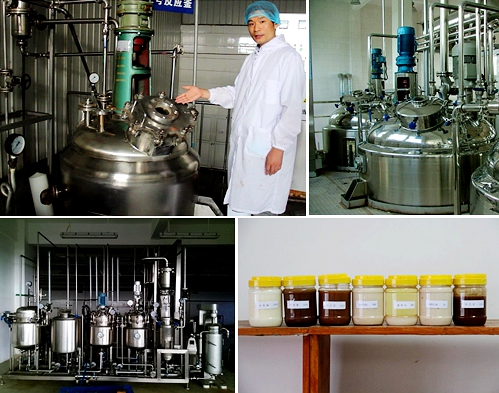分享到
Major breakthrough in key technologies and equipments for utilization of bone residues
Recently, a research team led by Professor Zhang Chunhui at the Institute of Agro-Products Processing Science and Technology (IAPPST) of Chinese Academy of Agricultural Sciences (CAAS) has successfully found an efficient way to transform bone residues (BR) to value-added food by combing technologies including hot-pressure extraction, enzymatic hydrolysis, Maillard reactions etc. together. This project has passed the appraisal by Ministry of Agriculture of China.
 As a byproduct of meat industry, BR contains approximately 51% moisture, 19% protein (35-40% is collagen), 9% fat, and 15% ash. Approximately 46 million tons of BR is produced in the world each year, and China contributes to more than 10 million tons of BR, thus representing a huge and valuable protein source. Studies had been carried out to explore effective ways of using BR as a protein resource, technologies including acidic, alkaline and enzymatic hydrolysis had been tried. However, due to the hard and stable structure of bone, the efficiency is low. Besides, pleasant taste and flavor of food from by-products is another important quality of food from byproducts. Therefore, novel processing methods of bone residues are required to convert CB as a byproduct into more profitable and marketable products.
As a byproduct of meat industry, BR contains approximately 51% moisture, 19% protein (35-40% is collagen), 9% fat, and 15% ash. Approximately 46 million tons of BR is produced in the world each year, and China contributes to more than 10 million tons of BR, thus representing a huge and valuable protein source. Studies had been carried out to explore effective ways of using BR as a protein resource, technologies including acidic, alkaline and enzymatic hydrolysis had been tried. However, due to the hard and stable structure of bone, the efficiency is low. Besides, pleasant taste and flavor of food from by-products is another important quality of food from byproducts. Therefore, novel processing methods of bone residues are required to convert CB as a byproduct into more profitable and marketable products.
To extract out the protein from bone residues efficiently, hot-pressure extraction were applied and more than 80% of the protein in bone residues can be extracted out. Enzymatic hydrolysis showed that resulting bone extracts (BE) showed a desirable value of protein digestibility–corrected amino acid score for adult. The total amino acid (AA) content of BE is 21.99 %, among which 40.62% and 54.66% are essential and fresh AA, indicating it is easy absorbed with fresh flavor. Maillard Reaction products of hydrolyzed BE showed reduced bitter taste and increased flavor amino acids and meaty-flavor compounds. Therefore, those combined technologies provide a strategy for preparation of natural meaty flavor enhancer or food supplements from bone residues.
More details are to be found in Food Chemistry, 2014, linked as:

To extract out the protein from bone residues efficiently, hot-pressure extraction were applied and more than 80% of the protein in bone residues can be extracted out. Enzymatic hydrolysis showed that resulting bone extracts (BE) showed a desirable value of protein digestibility–corrected amino acid score for adult. The total amino acid (AA) content of BE is 21.99 %, among which 40.62% and 54.66% are essential and fresh AA, indicating it is easy absorbed with fresh flavor. Maillard Reaction products of hydrolyzed BE showed reduced bitter taste and increased flavor amino acids and meaty-flavor compounds. Therefore, those combined technologies provide a strategy for preparation of natural meaty flavor enhancer or food supplements from bone residues.
More details are to be found in Food Chemistry, 2014, linked as:
http://www.sciencedirect.com/science/article/pii/S0308814614002180
By Wang Jinzhi
wjzlynn@gmail.com
Latest News
-
 Apr 18, 2024Opening Ceremony of the Training Workshop on Wheat Head Scab Resistance Breeding and Pest Control in Africa Held in CAAS
Apr 18, 2024Opening Ceremony of the Training Workshop on Wheat Head Scab Resistance Breeding and Pest Control in Africa Held in CAAS -
 Apr 03, 2024IPPCAAS Co-organized the Training Workshop on Management and Application of Biopesticides in Nepal
Apr 03, 2024IPPCAAS Co-organized the Training Workshop on Management and Application of Biopesticides in Nepal -
 Mar 28, 2024Delegation from the School of Agriculture and Food Science of University College Dublin, Ireland Visit to IAS, CAAS
Mar 28, 2024Delegation from the School of Agriculture and Food Science of University College Dublin, Ireland Visit to IAS, CAAS -
 Mar 25, 2024Director of World Food Prize Foundation visited GSCAAS
Mar 25, 2024Director of World Food Prize Foundation visited GSCAAS -
 Mar 20, 2024Institute of Crop Sciences (ICS) and Syngenta Group Global Seeds Advance Collaborative Research in the Seed Industry
Mar 20, 2024Institute of Crop Sciences (ICS) and Syngenta Group Global Seeds Advance Collaborative Research in the Seed Industry
